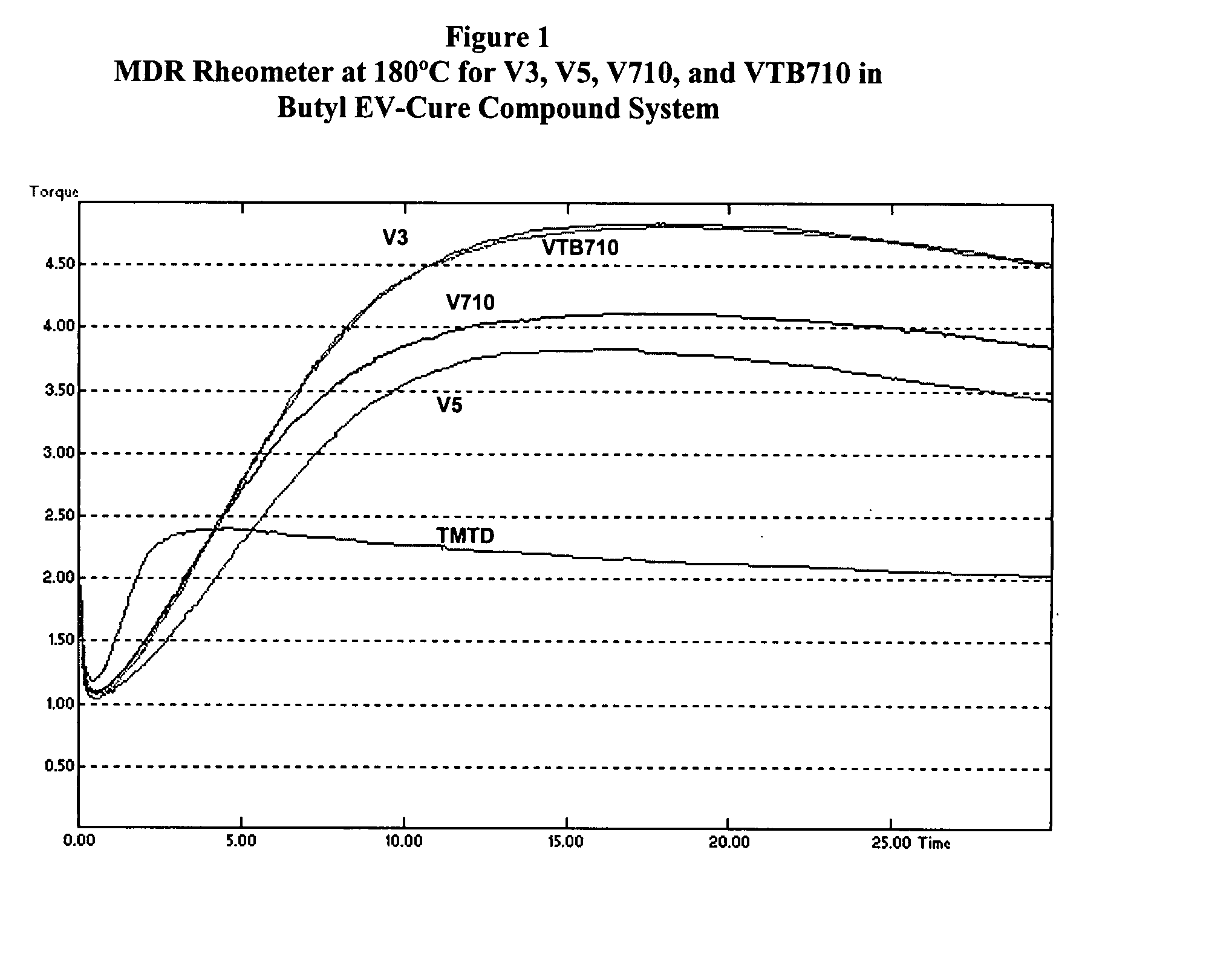Cure systems for rubber compounds
a technology of cure systems and rubber compounds, which is applied in the field of vulcanization of butyl rubber and halobutyl rubber compounds, can solve the problems of undesirable nitrosamine formation, scorch resistance performance, etc., and achieve the effects of improving at least one of reversion resistance, adhesion and tear strength, and improving one or more of reversion resistan
- Summary
- Abstract
- Description
- Claims
- Application Information
AI Technical Summary
Benefits of technology
Problems solved by technology
Method used
Image
Examples
example 3
Screening of V3, V5, V710, and VTB710 with a Butyl Semi-EV Cure System
[0034]The four alkylphenol disulfide accelerators, V3, V5, V710, and VTB710, were screened using the model butyl rubber formulation shown in Table I, with sulfur at 2.0 phr, and the results have been listed in Table VI. From Table VI it can be noted that:[0035]1. The alkylphenol disulfide accelerators had no effect on compound viscosity, as might be expected.[0036]2. TMTD had much shorter rheometer induction (t10), cure time (t90), and faster cure rate. The cure state (rheometer ΔT) was also greater. This was also seen in higher tensile strength and 300% modulus.
[0037]The rheometer profiles are illustrated in FIG. 2. Though the compound containing TMTD showed higher cure state and tensile strength, it is more susceptible to reversion compared to the alkylphenol disulfide cured compounds. This is further shown in aged tensile strength retention properties. Table VII compares the % retained tensile strength for the ...
example 4
Screening of V3, V5, V710, and VTB710 with a Bromobutyl Model Compound
[0043]The four alkylphenol disulfide accelerators were screened in the model bromobutyl rubber formulation shown in Table II. MBTS was not adjusted with the addition of the alkylphenol disulfide polymer accelerators To compensate for potential over cure, the levels of V3, V5, V710, and VTB710 were reduced from 3.0 phr used in the butyl compound screening work to 2.0 phr. Table IX shows the results of the screening work in the model bromobutyl compound. Briefly:[0044]1. Rheometer induction times (t10) and cure times (t90) were shorter with addition of the alkylphenol disulfide polymer accelerators.[0045]2. Cure state (rheometer ΔT) was higher. Given the high state of cure (FIG. 4), synergistic effects between the MBTS and V3, V5, V710, or VTB710 could be speculated.[0046]3. Addition of alkylphenol disulfide accelerators resulted in an increase in tensile strength and modulus. Tear strength and hardness were essenti...
PUM
| Property | Measurement | Unit |
|---|---|---|
| temperatures | aaaaa | aaaaa |
| temperatures | aaaaa | aaaaa |
| temperatures | aaaaa | aaaaa |
Abstract
Description
Claims
Application Information
 Login to View More
Login to View More - R&D
- Intellectual Property
- Life Sciences
- Materials
- Tech Scout
- Unparalleled Data Quality
- Higher Quality Content
- 60% Fewer Hallucinations
Browse by: Latest US Patents, China's latest patents, Technical Efficacy Thesaurus, Application Domain, Technology Topic, Popular Technical Reports.
© 2025 PatSnap. All rights reserved.Legal|Privacy policy|Modern Slavery Act Transparency Statement|Sitemap|About US| Contact US: help@patsnap.com



